2,5-Diketopiperazine
2,5-Diketopiperazine, also known as piperazine-2,5-dione and as the cyclodipeptide cyclo(Gly-Gly), is an organic compound and the smallest cyclic dipeptide that consists of a six-membered ring containing two amide linkages where the two nitrogen atoms and the two carbonyls are at opposite positions in the ring. It was first synthesized by Curtius and Gloebel in 1888[1] and was the first compound containing a peptide bond to be studied by X-ray crystallography in 1938.[2] It occurs in cocoa and bread and has a metallic and bitter taste.[3]
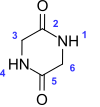 | |
| Names | |
|---|---|
| IUPAC name
2,5-Piperazinedione | |
| Other names
piperazine-2,5-dione cyclo(Gly-Gly) | |
| Identifiers | |
3D model (JSmol) |
|
| 3DMet | |
| 112112 | |
| ChEBI | |
| ChEMBL | |
| ChemSpider | |
| EC Number |
|
| 217756 | |
| KEGG | |
PubChem CID |
|
| UNII | |
| |
| |
| Properties | |
| C4H6N2O2 | |
| Molar mass | 114.104 g·mol−1 |
| Melting point | 311–312 °C (592–594 °F; 584–585 K) |
Except where otherwise noted, data are given for materials in their standard state (at 25 °C [77 °F], 100 kPa). | |
| Infobox references | |
2,5-Diketopiperazines (2,5-DKPs) which include mono- and disubstituted 2,5-diketopiperazines, their annulated, spiro-annulated and bridged derivatives are amongst the most ubiquitous peptide derivatives found in nature. They are found in fermentation broths and yeast cultures and this subunit is often found alone or embedded in larger more complex architectures in a variety of natural products isolated from fungi, bacteria, plants, and mammals, and their core structure occurs in several drugs.[4] In addition, they are often produced as degradation products of polypeptides, especially in processed food and beverages,[3] and have been identified in the contents of comets.[5]
Occurrence as natural products
There is a widespread occurrence of the 2,5-diketopiperazine core in biologically active natural products. The most structurally diverse 2,5-diketopiperazine natural products are based on tryptophan and proline modified by heterocyclisation and isoprenyl addition. These range from the hepatoxic brevianamide F (cyclo(L-Trp-L-Pro)) to the annulated tremorogenic verruculogen and the spiro-annulated spirotryprostatin B which represent a promising class of antimitotic arrest agents, to the structurally complex (+)-stephacidin A, a bridged 2,5-diketopiperazine that possess a unique bicyclo[2.2.2]diazaoctane core ring system and is active against the human colon HCT-116 cell line.[4]
- Biologically active Tryptophan-Proline 2,5-Diketopiperazine Natural Products
.svg.png)
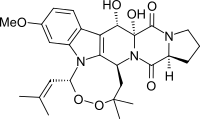
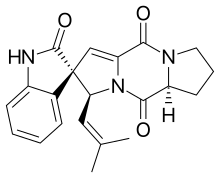
_Stephacidin_A.svg.png) (+)Stephacidin A
(+)Stephacidin A
Other bridged 2,5-diketopiperazines include bicyclomycin, an antibacterial agent used as food additives to prevent diarrhea in animals while the thio derivatives such as the cytotoxic bridged epipolythiodioxopiperazine are represented by gliotoxin. The unsaturated derivatives are illustrated by phenylahistin the anti-cancer microtubule binding agent, and the mycotoxin roquefortine C found in blue cheeses.[4]
- Other Biologically active 2,5-Diketopiperazine Natural Products
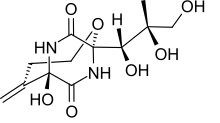

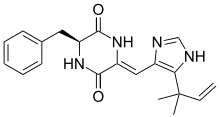
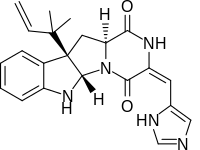
Occurrence in foods and beverages
2,5-Diketopiperazines are often formed during chemical and thermal processing of food and beverages as the degradation products of polypeptides. They have been detected in stewed beef, beer, bread, Awamori spirits, cocoa, chicken essence, roasted coffee, Comte cheese, dried squid, aged saki and yeast extract. In food systems, 2,5-diketopiperazines have been shown to be important sensory compounds contributing to the taste of the final products and being perceived as astringent, salty, grainy, metallic or bitter. Although these range from proline, aromatic, aliphatic to polar 2,5-diketopiperazines, the proline 2,5-diketopiperazines are the most abundant and structurally diverse 2,5-diketopiperazines found in food. The valine derivative cyclo(L-Val-L-Pro) at a concentration of 1742 ppm, was identified as the most important bitter 2,5-diketopiperazine contributing to the bitter taste of roasted cocoa. It has also been found as one of the major 2,5-diketopiperazines in autolyzed yeast extract and stewed beef and is also present in chicken essence and coffee.[3] It has also been isolated from a variety of marine microorganisms and has been identified as an active LasI quorum-sensing signal molecule important for the plant growth promotion by Pseudomonas aeruginosa.[4] The most studied of all the simple 2,5-diketopiperazines is the histidyl-proline 2,5-diketopiperazine cyclo(L-His-L-Pro)[6] which is found in a variety of foods, with particularly high concentrations in fish and fish products. It is well absorbed orally, and crosses the blood–brain barrier via a non-saturable mechanism. It also occurs in humans[7] as a metabolite from the thyrotropin-releasing hormone (TRH) and exhibits a wide variety of central nervous system, endocrine, electrophysiological, and cardiovascular effects.[6] Derivatives of cyclo(L-His-L-Pro) have been studied extensively to develop therapeutic agents for neurodegeneration.[8][4]
Structure and conformation
The 2,5-diketopiperazines (2,5-DKPs) are the smallest possible cyclic peptides, which are peptidomimetic in nature and bear resemblance with a constrained protein beta turn. These cyclic dipeptides incorporate both donor and acceptor groups for hydrogen bonding and are small, conformationally constrained heterocyclic scaffolds in which diversity can be introduced at up to six positions and stereochemistry controlled at up to four positions, and they are stable to proteolysis. These characteristics enable them to bind to a wide range of receptors which result in a widespread class of biologically active natural compounds. They have a rigid backbone, which can mimic a preferential peptide conformation and contain constrained amino acids embedded within their structures without the unwanted physical and metabolite properties of peptides. This improves their bioavailability and resistance to enzymatic degradation in comparison to their linear analogues.[4]

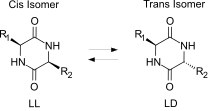
These conformationally constrained heterocycles are flexible because the six-membered ring can exist in an essentially flat conformation 1 or a slightly puckered boat form 2, with only a few kcal/mol difference in energy between the boat and planar forms. In addition, the 2,5-DKPs can be configured as both cis and trans isomers. As a consequence of their predominant biosynthetic origin from L-α-amino acids most naturally occurring 2,5-DKPs are cis configured as the cyclo(L-Xaa-L-Yaa) isomers. However, 2,5-DKPs epimerize under basic, acidic and thermal conditions. The composition of the cis and trans isomers in the equilibrium state varies widely depending on the bulk of the side chains, if a ring (e.g. proline) is present, or if the nitrogen atoms are alkylated . Although epimerization was historically an issue in the synthesis of 2,5-DKPs, several mild methods have been developed recently that avoid epimerization.[4]
Synthesis
In the synthesis of 2,5-diketopiperazines there are essentially three methods of ring closure: amide bond formation, N-alkylation and C-acylation.
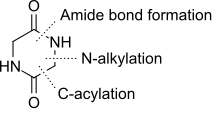
Amide bond formation
The most commonly used synthesis of 2,5-diketopiperazines 3 is amide bond formation by cyclisation of dipeptide 1 or 2. These dipeptides can be formed by coupling two amino acids together by the many methods of peptide synthesis or by using the Ugi reaction of an isonitrile, amino acid, aldehyde and amine, followed by deprotection.
Dipeptides substituted with an amine at one terminus and an ester at the other 1 can spontaneously cyclize to form a 2,5-diketopiperazine at a range of pHs. However, careful selection of reaction conditions is required to limit racemization. This has been achieved in a general, efficient, and environmentally benign solution-phase synthesis of 2,5-diketopiperazines using microwave-assisted heating in water,[9] which in contrast to other published methods is independent of the amino acid sequence, and no epimerization was seen.
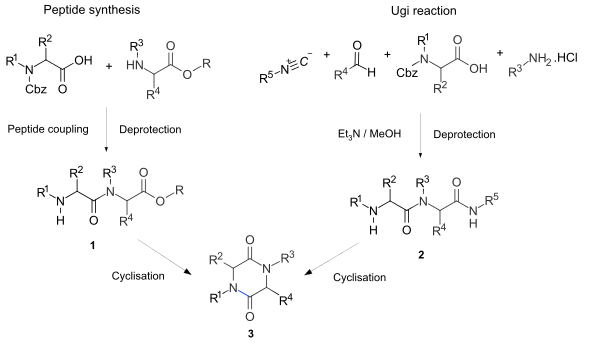
The Ugi reaction using an isonitrile, amino acid, aldehyde and amine, can produce a dipeptide in equally high yield and optical purity, to that formed by standard peptide couplings.[10] Commonly, an isonitrile is chosen to give a labile terminal amide to enable cyclization. For example, the direct 2,5-DKP ring formation via such an activated leaving group using the stable, easily accessible and versatile convertible isonitrile 1-isocyano-2-(2,2-dimethoxyethyl)-benzene 4 gave a one-pot synthesis of N-substituted 2,5-diketopiperazine's 7.[11]
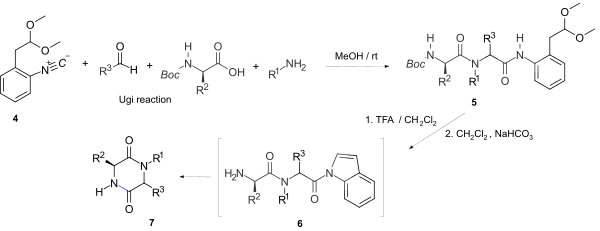
The mild acidic and chemoselective post Ugi activation of 5 involving simultaneous indolamide formation and tert-butoxycarbonyl (Boc) removal gives the active amide 6 which allows cyclization to 7 without affecting other peptidic or even ester moieties and with stereochemical retention of the chiral centers.
N-Alkylation
Intramolecular amide N-alkylation of alpha-haloacetamide amides 8 with ethanolic potassium hydroxide using ultrasonication gave the 2,5-diketopiperazines 9, where 8 was obtained by an Ugi reaction[12] between amines, aldehydes, isocyanides, and chloroacetic acid. However this route is limited by epimerization at the stereogenic centre and failure to obtain the 2,5-diketopiperazine ring if R1 = Alkyl.

C-Acylation
Formation of the 2,5-diketopiperazine ring by enolate acylation[13] was used in the construction of the 2,5-diketopiperazine ring in 11 by intramolecular cyclization of the enolate of 10 onto the carbonyl of the phenyl carbamate to give 11 in 90% yield.

Reactions
Reactivity at carbon (C-3 and C-6)
Regio- and sterocontrolled C-functionalization of 2,5-diketopiperazines at C-3 and C-6 involve enolate, radical and cationic precursors (and N-acyliminium ion) and are sensitive to polar and steric effects.
Alkylation of enolates
Alkylation of the bis-paramethoxybenzyl (pMB) protected 2,5-DKP 1 using the base LHMDS and an alkyl bromide R1Br, gave the mono-alkylated derivative 2, which on further alkylation gave the symmetrical trans-disubstituted derivative 3

Halogenation and displacement
The 3-monobromides 6 and the 3,6-dibromides 5 are prepared from the benzyl protected 2,5-DKP 4 by radical halogenation with N-bromosuccinimide in carbon tetrachloride. Displacement of these labile bromides readily occurs with a range of nucleophiles SR, OR, NR2, alkyl and aryl to give 7 .[4]

Aldol addition
A one- or two-fold aldol condensation of N-acetylated 2,5-DKP 8 gives access to 3-dehydro-2,5-diketopiperazines 9 and 3,6-didehydro-2,5-diketopiperazines 10 and the condensation of 8 can controlled in a stepwise fashion using triethylamine in dimethylformamide to give the unsymmetrical 3,6-didehydro-2,5-diketopiperazines 10 (R1 = Ar1, R2 = Ar2).[4]

Reactivity at nitrogen
Alkylation
The most common method for alkylation of the lactam nitrogen of 2,5-diketopiperazines is based on the use of sodium hydride as base. However epimerisation can occur especially with proline-fused 2,5-diketopiperazines, even with milder methods such as under phase-transfer catalyst conditions for example 1 to 2.[4]

Reactivity at carbonyl carbons (C-2 and C-5)
Reduction
Reduction of the carbonyl groups of chiral 2,5-diketopiperazine with lithium aluminium hydride (LiAlH4) cleanly gives the corresponding chiral piperazines. For example, cyclo(L-Phe-L-Phe) 1 gives the chiral piperazine (2S,5S)-dibenzylpiperazine 2.[14]

Dihydropyrazine and pyrazine synthesis
Reaction of the lactam-derived enol phosphates 4 of 2,5-diketopiperazines with palladium catalyzed reactions (reduction, Suzuki and Stille cross-coupling reactions) enables the synthesis of a range of functionalised 1,4-dihydropyrazines 5 which can be aromatized to 1,4-pyrazines 6 in the presence of acid.[15]

Applications
Therapeutics
There are numerous bioactive molecules containing the 2,5-DKP core template in the literature arising from natural products and available from combinatorial libraries. These small, conformationally rigid, chiral templates have multiple H-bond acceptor and donor functionality and have multiple sites for structural elaboration of diverse functional groups with defined stereochemistry. These characteristics not only enable them to bind with high affinity to a large variety of receptors, showing a broad range of biological activities, but also allow the development of the drug-like physicochemical properties required for the multiobjective optimization process of transforming a lead to a drug product. The structure–activity relationship (SAR) has been explored for many of these 2,5-DKP templates, and several have been developed into clinical drugs. These include tadalafil (a PDE5 inhibitor for erectile dysfunction), retosiban (an oxytocin antagonist for preterm labor), aplaviroc (a CCR5 antagonists for HIV), epelsiban (an oxytocin antagonist for premature ejaculation) and the experimental cancer drug plinabulin (NPI-2358/KPU-2) that is active in multidrug-resistant (MDR) tumor cell lines.[4]
- 2,5-Diketopiperazine Therapeutics
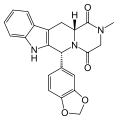
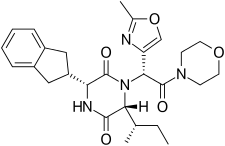
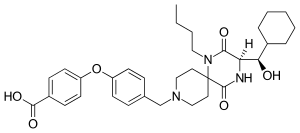
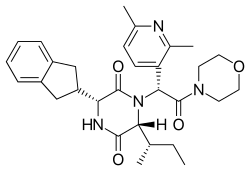
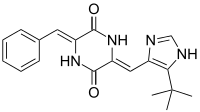
Reagents
The diketopiperazine obtains from glycylserine is a reagent for the preparation of C-alkylated derivatives of glycine. This approach is useful for the production of unnatural amino acids with stereochemical control. The diketopiperazine skeleton protects both the N and O termini of the glycine. For this application, the diketopiperazine is O-alkylated with concomitant N-deprotonation to give what is called the Schöllkopf reagent.[16]
References
- Curtius T; Goebel F (June 1888). "Ueber Glycocolläther". Journal für Praktische Chemie. 37: 150–181. doi:10.1002/prac.18880370113.
- Corey RB (July 1938). "Crystal Structure of Diketopiperazine". Journal of the American Chemical Society. 60 (7): 1598–1604. doi:10.1021/ja01274a023.
- Borthwick AD; Da Costa NC (2017). "2,5-Diketopiperazines in Food and Beverages: Taste and Bioactivity". Critical Reviews in Food Science and Nutrition. 57 (4): 718–742. doi:10.1080/10408398.2014.911142. PMID 25629623.
- Borthwick AD (May 2012). "2,5-Diketopiperazines: Synthesis, Reactions, Medicinal Chemistry, and Bioactive Natural Products". Chemical Reviews. 112 (7): 3641–3716. doi:10.1021/cr200398y. PMID 22575049.
- Shimoyama A, Ogasawara R (April 2002). "Dipeptides and diketopiperazines in the Yamato-791198 and Murchison carbonaceous chondrites". Origins of Life and Evolution of the Biosphere. 32 (2): 165–179. doi:10.1023/A:1016015319112. PMID 12185674.
- Minelli A, Bellezza I, Grottelli S, Galli F (Aug 2008). "Focus on cyclo (His-Pro): history and perspectives as antioxidant peptide". Amino Acids. 35 (2): 283–289. doi:10.1007/s00726-007-0629-6. PMID 18163175.
- Prasad C (Dec 1995). "Bioactive cyclic dipeptides". Peptides. 16 (1): 151–164. doi:10.1016/0196-9781(94)00017-Z. PMID 7716068.
- Cornacchia C, Cacciatore I, Baldassarre L, Mollica A, Feliciani F, Pinnen F (Jan 2012). "Diketopiperazines as neuroprotective agents". Mini Reviews in Medicinal Chemistry. 12 (1): 2–12. doi:10.2174/138955712798868959. PMID 22070690.
- Tullberg M, Grøtli M, Luthman K (July 2006). "Efficient synthesis of 2, 5-diketopiperazines using microwave assisted heating". Tetrahedron. 62 (31): 7484–7491. doi:10.1016/j.tet.2006.05.010.
- Dömling A (January 2006). "Recent developments in isocyanide based multicomponent reactions in applied chemistry". Chemical Reviews. 106 (1): 17–89. doi:10.1021/cr0505728. PMID 16402771.
- Rhoden CR, Rivera DG, Kreye O, Bauer AK, Westermann B, Wessjohann LA (October 2009). "Rapid Access to N-substituted diketopiperazines by one-pot Ugi-4CR/deprotection+ activation/cyclization (UDAC)". Journal of Combinatorial Chemistry. 11 (6): 1078–1082. doi:10.1021/cc900106u. PMID 19795905.
- Marcaccini S, Pepino R, Pozo MC (April 2001). "A facile synthesis of 2, 5-diketopiperazines based on isocyanide chemistry". Tetrahedron Letters. 42 (14): 2727–2728. doi:10.1016/S0040-4039(01)00232-5.
- Peng J, Clive DL (December 2008). "Asymmetric Synthesis of the ABC-Ring System of the Antitumor Antibiotic MPC1001". The Journal of Organic Chemistry. 74 (2): 513–519. doi:10.1021/jo802344t. PMID 19067592.
- Nagel U, Menzel H, Lednor PW, Beck W, Guyot A, Bartholin M (May 1981). "Versuche zur Rhodium (I)-katalysierten asymmetrischen Hydrierung von α-Acetamidozimtsäure mit monomeren und polymeren Aminophosphinen/Rhodium (I) Catalyzed Asymmetric Hydrogenation of α-Acetamido Cinnamic Acid with Monomeric and Polymeric Aminophosphines". Zeitschrift für Naturforschung B. 36 (5): 578–584. doi:10.1515/znb-1981-0510.
- Chaignaud M, Gillaizeau I, Ouhamou N, Coudert G (August 2008). "New highlights in the synthesis and reactivity of 1, 4-dihydropyrazine derivatives". Tetrahedron. 64 (35): 8059–8066. doi:10.1016/j.tet.2008.06.080.
- Wirth, Thomas (1997). "New Strategies toα-Alkylatedα-Amino Acids". Angewandte Chemie International Edition in English. 36 (3): 225–227. doi:10.1002/anie.199702251.